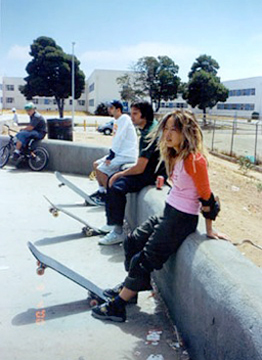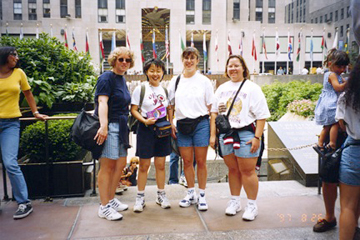What’s the place of contemporary art in schools? What’s the place of “controversial” contemporary art in schools? And what’s our responsibility as teachers?
The very best contemporary art speaks a language our students can understand. One of the great gifts of Art:21 is that we can introduce our students to artists who LOOK and SOUND like they do, and who are making art that deals with issues that are important to them.
Kids grapple with issues of sex and identity early on. Stereotypes abound: girls are princesses, boys are athletes; girls are good at art and boys are good at math. Beautiful people are tall, light-skinned, with clear complexions and good hair and are very, very thin. What’s a regular every day kid to do?
A few years ago we presented a show called Sugar and Snails. It was created in response to a desire to have open conversations with our students about issues of gender identity and body image. Even at very early ages kids deal with questions like these, and it’s our job to help them make healthy choices.
Samantha Salzinger’s Skin Deep Series provided opportunities for our middle and upper school students to directly confront issues about beauty. For adolescent girls AND boys conversations about eating (or not), complexions, hair, makeup, tanning, tattooing and piercing, exercising and all sorts of other physical issues are every day occurrences. Salzinger’s large format portraits of patients recovering from plastic surgery called into question all of our assumptions, both student and adult, about the price of beauty.

Samantha Salzinger, from the Skin Deep Series
Our students responded with works of their own. Human sexuality teacher Debbie Roffman asked middle school students to create collages that highlighted the stereotypes and subliminal sexual messages in popular culture. Their work showed their understanding that sex sells everything from beauty products to cars to home appliances. In their collages, the students created thoughtful, funny, often startling pieces and raised our awareness about how the media helps reinforce stereotypes.

Nikki S. Lee, #7 from The Skateboarders Project (2000)

Nikki S. Lee, The Tourist Project #9 (1997)
Photographer Nikki S. Lee’s work really called into question the whole idea of fitting in. In her Projects, Lee identifies a group (tourists, Hispanics, yuppies, elderly people, lesbians, and others) and works to transform herself to be as much like them as possible. That’s Lee herself in the foreground of the skateboarders piece and second from left in the tourist piece. Our students looked at works like these and (almost without fail) took a closer look at how they, too, reinvent themselves to conform to a group norm. It happens very early, doesn’t it, when “everyone” has a particular shoe or backpack or haircut? Nikki S. Lee’s work provides an opportunity to talk to kids about it.
It’s work like this that helps open conversations with kids about issues that make a difference.
Check out more about Nikki S. Lee in this month’s Art Education magazine: Identity in Flux: Exploring the Work of Nikki S. Lee by Amanda Allison. It includes lesson plans for grades 9-12 that explore identity within contemporary subculture groups. January 2009, Volume 62, No.1.
Carolyn Sutton is Director of Arts at The Park School in Baltimore and a member of Art21’s National Education Advisory Council.




Pingback: Contemporary Art in Schools | new curator